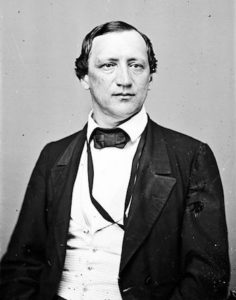
John S. Carlile
On this date in 1861, West Virginia began the Secessionist Convention that would break away from the Confederate state of Virginia, the only state to form by secession and one of three states to secede from another. It was a key American Civil War "border state."
Abraham Lincoln was elected president of the United States a year earlier with virtually no support from the South. His election resulted in the country's southernmost states leaving the Union and forming the Confederate States of America. On April 17, 1861, days after Lincoln's order to seize Fort Sumter in South Carolina, a convention of Virginians voted to submit a secession bill to the people. Led by Virginia's John S. Carlile (shown) of Clarksburg, western delegates marched out of the Secession Convention, vowing to form a state government loyal to the Union.
Many of these delegates called for a pro-Union convention, which met in Wheeling on May 13, 1861. Ten days later, most Virginia voters approved the Ordinance of Secession. Following a Union victory at the Battle of Philippi and General George B. McClellan's subsequent occupation of northwestern Virginia, the Second Wheeling Convention met between June 11 and June 25, 1861.
On October 24 of that year, residents of 39 counties in western Virginia approved the formation of a new Unionist state. The accuracy of these election results has been questioned since Union troops were camped out at many of the polls to prevent Confederate sympathizers from voting.
At the Constitutional Convention, which met in Wheeling from November 26, 1861, to February 1862, delegates selected the counties for inclusion in the new state of West Virginia. From the initial list, Confederate troops and many local Confederate sympathizers excluded most of the counties in the Shenandoah Valley. Ultimately, 50 counties were selected (all of present-day West Virginia's counties except Mineral, Grant, Lincoln, Summers, and Mingo, formed after statehood).
The honesty of these election results has been questioned since the Union army occupied the area. Union troops were stationed at many polls to prevent Confederate sympathizers from voting. The instrument was ratified (18,162 for and 514 against) on April 11, 1862. West Virginia was admitted to the Union as a separate state on June 20, 1863.
Delegates formed the Restored, or Reorganized, Government of Virginia and chose Francis H. Pierpont as governor. President Lincoln recognized the Restored Government as the legitimate government. Carlile and Waitman T. Willey became United States senators, and Jacob B. Blair, William G. Brown, and Kellian V. Whaley became congressmen representing pro-Union Virginia.
Most eastern and southern counties did not support statehood but were included for political, economic, and military purposes. The mountain range west of the Blue Ridge became the eastern border of West Virginia to provide a defense against Confederate invasion. One of the most controversial decisions involved the Eastern Panhandle counties, which supported the Confederacy. The Baltimore and Ohio Railroads, which ran through the Eastern Panhandle, were extremely important for the economy and troop movements. The inclusion of these counties removed the entire railroad from the Confederacy.
In terms of the Constitution itself, slavery produced the most controversy. Delegate Gordon Battelle proposed the gradual emancipation of slaves already in the state and freedom to all children born to slaves after July 4, 1865. Although some delegates opposed Battelle's position, they knew they could not create a pro-slavery document and gain approval from Congress. Following much debate and give and take, the stipulation in the constitution banned the introduction of slaves or free Blacks into West Virginia. Still, it did not address the issue of immediate or gradual emancipation.
The United States Constitution requires a new state to gain approval from the original state, which never occurred in West Virginia.
The Encyclopedia Britannica, Fifteenth Edition.
Copyright 1996 Encyclopedia Britannica Inc.
ISBN 0-85229-633-0